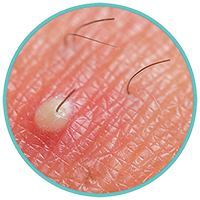Folliculitis is a common skin condition in which hair follicles become inflamed. It's usually caused by a bacterial or fungal infection. At first it may look like small red bumps or white-headed pimples around hair follicles — the tiny pockets from which each hair grows. The infection can spread and turn into non healing, crusty sores. The condition isn't life-threatening, but it can be itchy, sore and embarrassing. Severe infections can cause permanent hair loss and scarring. Mild cases are likely to clear in a few days with basic self-care measures. For more serious or recurring folliculitis, a prescription medicine may be needed.
The two main types of folliculitis are superficial and deep. The superficial type involves part of the follicle, and the deep type involves the entire follicle and is usually more severe. Forms of superficial folliculitis include bacterial folliculitis (staphylococcus aureus); hot tub folliculitis (pseudomonas folliculitis); razor bumps (skin irritation caused by ingrown hair); pityrosporum folliculitis (yeast infection). Forms of deep folliculitis include: Sycosis barbae; gram-negative folliculitis; boils (furuncles) and carbuncles ( deep hair follicles infection with staph bacteria); eosinophilic folliculitis (mainly affects people with HIV/AIDS, the cause is unknown).

Acne is a skin condition that occurs when hair follicles become plugged with oil and dead skin cells. It often causes whiteheads, blackheads or pimples, and usually appears on the face, forehead, chest, upper back and shoulders. Acne is most common among teenagers, though it affects people of all ages. Effective treatments are available, but acne can be persistent. The pimples and bumps heal slowly, and when one begins to go away, others seem to crop up. Depending on its severity, acne can cause emotional distress and scar the skin. The earlier the treatment starts, the lower is the risk of such problems.
Acne signs and symptoms vary depending on the severity of the condition: whiteheads (closed plugged pores); blackheads (open plugged pores); small red, tender bumps (papules); pimples (pustules), which are papules with pus at their tips; large, solid, painful lumps beneath the surface of the skin (nodules); painful, pus-filled lumps beneath the surface of the skin (cystic lesions).
If self-care remedies don't clear acne, primary care doctor needs to be consulted as he or she can prescribe targeted medications. If acne persists or is severe, your GP may a patient to a doctor who specializes in the skin (dermatologist).
For many women, acne can persist for decades, with flares common a week before menstruation. This type of acne tends to clear up without treatment in women who use contraceptives.
In older adults, a sudden onset of severe acne may signal an underlying disease requiring medical attention.
